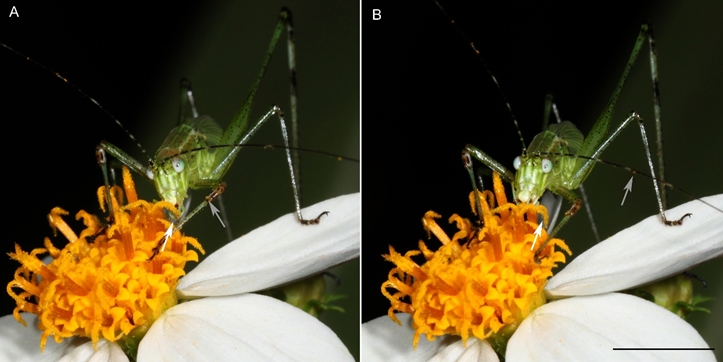Orthopterans are unexpected pollinators
NUS biologists have discovered that orthopterans (the insect group that includes crickets, grasshoppers and katydids) visit flowers more frequently than previously known and play a potential role in pollination.
Pollination is crucial for plant reproduction and animals help to pollinate 35% of our food crops. People generally associate pollination with bees, butterflies, bats and birds. Other animals and insects also contribute to pollination, but there is very little information on these species. Owing to the global biodiversity crisis, species are going extinct at an unprecedented rate. This deprives us of the potential value of biodiversity, such as goods and services that are not yet discovered but potentially benefits humankind. There is hence a pressing need to better understand pollination ecology, especially the beneficial roles insects play when they visit flowering plants.
Prof Hugh TAN and his Ph.D. student, Mr TAN Ming Kai from the Department of Biological Sciences, NUS have discovered that 41 different species of orthopterans visit the flowers of plants in Southeast Asia. This was done by surveying different vegetation types between 2015 and 2018 in Singapore, Malaysia, Thailand and Brunei Darussalam and making natural history observations. These involved both day and night surveys during which flower-visiting orthopterans were searched for and recorded using photographs and videos. Previously, there were only a few published records of orthopterans visiting flowers and none of these involved Southeast Asian species. Although orthopterans such as locusts and grasshoppers are usually considered agricultural pests that eat and destroy food crops, some species of these insects can be the pollinators of flowers they visit, thus providing a valuable service to plants. A series of animal behaviour experiments were conducted in an insectary by providing different combinations of flowering parts of plants to the insects. Close examination of the video recordings showed that the sickle-bearing katydid (Phaneroptera brevis) feeds on flowers without damaging them by gently collecting the pollen grains, and this can facilitate pollination. This was further corroborated by pollination experiments which demonstrated higher seed production when flowers were exposed to the katydids than when they were not.
Mr Tan said, “As more orthoptera species are being discovered in this region, we expect to find more of such pollinators.”
“These findings suggest that research on the pollination ecology of orthoptera is still in its infancy. More research and observational studies are needed to better understand the mutualistic–antagonistic relationship between flower eaters-cum-pollinators (including the katydids) and plants, and how these unorthodox pollinators co-evolved with plants,” added Prof Tan.

A sickle-bearing katydid nymph (juvenile) using its palps (mouth appendages) to collect pollen grains without damaging the flower parts (white arrows). Pollen grains attached to the antennae and legs of the katydid (grey arrows) can facilitate pollination. [Credit: Ecology (The Scientific Naturalist)]
References
Tan MK*; Artchawakom T; Wahab RA; Lee CY; Belabut DM; Tan HTW, “Overlooked flower visiting Orthoptera in Southeast Asia” JOURNAL OF ORTHOPTERA RESEARCH, 26(2), 143–153. DOI: 10.3897/jor.26.15021. Published: 2017.
Tan MK*; Tan HTW, “A gentle floriphilic katydid Phaneroptera brevis can help with the pollination of Bidens pilosa” ECOLOGY (THE SCIENTIFIC NATURALIST) DOI: 10.1002/ecy.2369. Published: 2018.
